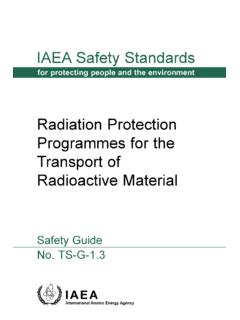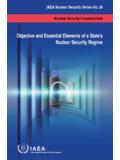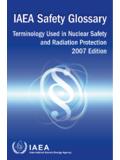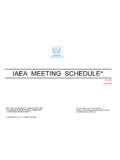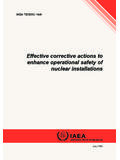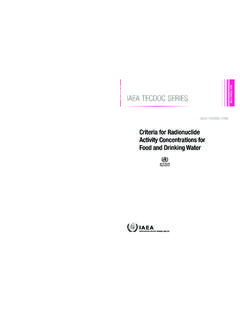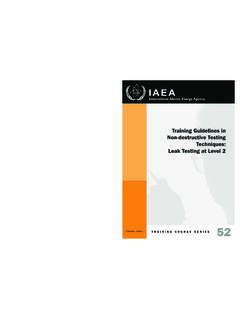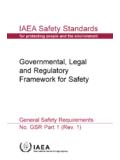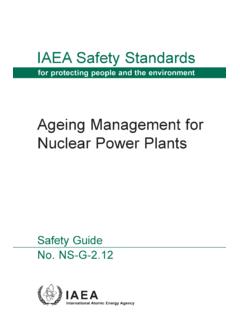Transcription of Collection and preparation of bottom sediment samples for ...
1 IAEA-TECDOC-1360. Collection and preparation of bottom sediment samples for analysis of radionuclides and trace elements July 2003. The originating Section of this publication in the IAEA was: Nutritional and Health-Related Environmental Studies Section International Atomic Energy Agency Wagramer Strasse 5. Box 100. A-1400 Vienna, Austria Collection AND preparation OF bottom sediment samples FOR. ANALYSIS OF RADIONUCLIDES AND TRACE ELEMENTS. IAEA, VIENNA, 2003. IAEA-TECDOC-1360. ISBN 92 0 109003 X. ISSN 1011 4289. IAEA, 2003. Printed by the IAEA in Austria July 2003.
2 FOREWORD. The IAEA has been providing support to developing Member States in the use of nuclear and nuclear related techniques for various applications, with special reference to environmental studies. With a view to helping to develop analytical facilities and capabilities in order to achieve scientific progress and social development, the IAEA has been promoting the growth of science in Member States over several years by disseminating information in the form of TECDOCs on focussed themes. The present publication is the first in a series of TECDOCs on sampling and sample handling as part of the IAEA support to improve reliability of nuclear analytical techniques (NATs) in Member State laboratories.
3 One of the major global concerns since the 1960s has been the monitoring of environmental changes to understand the implications of various anthropogenic activities in the post- industrial era. Important compartments of the environment are air, water, vegetation, particulate matter, soil, biological organisms and sediments. A large number of advanced techniques have been developed to monitor the environment; however, the measured analytical data are crucially based on the sampling and sample preparation of the chosen matrix, sediments. Changes in contamination, biological status and physical characteristics of lakes, rivers and coastal marine systems during the past have often led to significant changes in the composition of accumulating sediments.
4 Sediments are the sinks for elemental cycles in aquatic systems and are recognized as one of the largest sources of in- place pollutants. Therefore sediments are the host for pollutants and provide information on the various processes such as sedimentation, water dynamics, sediment contaminant interaction, sediment organism interaction and historical indicators. Thus, the analysis of sediments can aid in reconstructing the history of changes, understanding human impact on the ecosystem, and suggesting possible remedial strategies. In order to arrive at the best possible practices that could be adopted by the Member States, a consultants meeting was organized on Collection and preparation of bottom sediment samples for analysis of radionuclides and trace elements from 10 to 14 January 2000 in Vienna.
5 The subject of the meeting was confined to bottom sediments with a focus on Collection and sample preparation as a crucial step in the entire analytical process. Although there are many approaches and methods available for sediment analysis, the scope of this report is limited to sample preparation for (1) analysis of radionuclides, including sediment dating using radionuclides such as 210Pb and 137Cs and (2) analysis of trace, minor and major elements using nuclear and related analytical techniques such as neutron activation analysis, X ray fluorescence and particle induced X ray emission.
6 The purpose of this TECDOC is to provide information on the methods for collecting sediments, the equipment used, and the sample preparation techniques for radionuclide and elemental analysis. The TECDOC is intended to be a comprehensive manual for the Collection and preparation of bottom sediments as a prerequisite to obtain representative and meaningful results using NATs. Quality assurance and quality control (QA/QC) is emphasized as an important aspect to ensure proper Collection , transportation, preservation, and analysis since it forms the basis for interpretation and legislation.
7 The report consists of the summary of the theme and discussions, followed by conclusions and texts of the presentations by the experts during the meeting. The IAEA is grateful to the experts for their contribution to this report. From the IAEA, B. Smodi , Division of Human Health and Annareddy and M. Rossbach of the Division of Physical and Chemical Sciences, were responsible for preparing this TECDOC. EDITORIAL NOTE. This publication has been prepared from the original material as submitted by the authors. The views expressed do not necessarily reflect those of the IAEA, the governments of the nominating Member States or the nominating organizations.
8 The use of particular designations of countries or territories does not imply any judgement by the publisher, the IAEA, as to the legal status of such countries or territories, of their authorities and institutions or of the delimitation of their boundaries. The mention of names of specific companies or products (whether or not indicated as registered) does not imply any intention to infringe proprietary rights, nor should it be construed as an endorsement or recommendation on the part of the IAEA. The authors are responsible for having obtained the necessary permission for the IAEA to reproduce, translate or use material from sources already protected by copyrights.
9 CONTENTS. 1. 1. Scientific and technical 1. Scope of the 1. 2. GENERAL SAMPLING STRATEGY .. 2. Selecting sampling 2. Navigation .. 2. Sampling approaches .. 3. Sampling 4. Representativeness of the sample .. 5. Quality assurance and quality control during 5. 3. Collection OF sediment 5. sediment environment: Variability with respect to different water bodies .. 7. Grab sediment 9. Objective of Collection .. 9. Types of sampling 9. Advantages and disadvantages of different 11. sediment 11. Objective of Collection .. 11. Types of coring devices .. 11. Extruding and 17.
10 4. TRANSPORTATION AND STORAGE .. 17. Containers for sediment 17. Cleaning procedures for containers .. 18. Precautions during sample 19. 5. CRITICAL PARAMETERS FOR DATA 20. Particle size analysis .. 20. Organic component role .. 20. Water content of 20. Salt correction for drying marine 20. 6. PRE-TREATMENT AND 21. Drying of 21. Fractionation of 23. Homogenization and 23. Preservation of samples .. 24. 7. preparation OF samples FOR ANALYSIS .. 25. Non-destructive sample preparation .. 26. Destructive sample preparation .. 27. Quality assurance/quality control for sample preparation .
